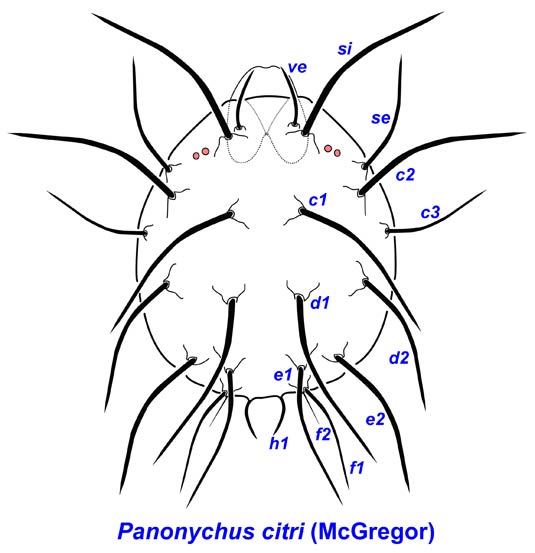Panonychus
Superfamily Tetranychoidea
Family Tetranychidae
Subfamily Tetranychinae
Tribe Tetranychini
Genus Panonychus
Common names: Citrus red mite, European red mite, Raspberry red mite
Probability of Encounter: Very high
Quarantine importance: High. Panonychus is a small genus of about 15 described species including a couple of broadly distributed and highly polyphagous pests such as the European red mite P. ulmi (Koch), the Raspberry mite P. caglei Mellot, and the Citrus red mite P. citri McGregor. At the current time, the USA has most of the important pests and only one exotic species of Panonychus is considered of high quarantine interest:
-
Panonychus elongatus Manson attacks beans, citrus, figs, papaya, passion fruit, pear, and ornamentals such as rose in Asia, Australia, and New Guinea.
Diagnosis:
-
With 2 pairs of paranal setae (h2-h3); 2 pairs of anal setae.
-
Empodium claw-like and as long or longer than the proximoventral hairs.
-
Dorsal setae are usually set on strong tubercles.
-
Peritremes recurved distally.

Similar taxa. Other Tetranychini have either 1 pair of paranal setae (e.g. Oligonychus, Tetranychus, Amphitetranychus) or have the empodium split distally, ending in a tuft of hairs, or divided into 2-3 claws or lack proximoventral hairs or have hairs longer than the claw (Allonychus).
References
Baker EW & AE Pritchard. 1960. The tetranychoid mites of Africa. Hilgardia 29(11): 455-574.
Baker EW & DM Tuttle. 1994. A guide to the spider mites (Tetranychidae) of the United States. Indira Pub. House, West Bloomfield, MI: 347 pp.
Beard JJ, Walter DE, & Allsopp P. 2003. Spider Mites of Sugarcane in Australia: A Review of Grass-feeding Oligonychus Berlese (Acari: Prostigmata: Tetranychidae) with the description of four new species. Australian Journal of Entomology 42: 51-78.
Bolland HR, J Gutierre & CHW Flechtmann. 1998. World Catalogue of the Spider Mite Family (Acari: Tetranychidae). Brill: Leiden.
Helle W & MW Sabelis (eds.) 1985. Spider Mites, Their Biology, Natural Enemies, and Control, vol. 1A. Elsevier: New York.
Jeppson LR, HH Keifer & EW Baker. 1975. Mites Injurious to Economic Plants, University of California Press: Berkeley
Meyer, M.K.P. 1974. A revision of the Tetranychidae of Africa (Acari) with a key to the genera of the world. Dept. Agr. Tech. Serv. Mem. 36: 291 pp.
Meyer, M.K.P. Smith 1987. African Tetranychidae (Acari: Prostigmata) - with reference to the world genera. S. Afr. Dept. Agr. Water Supply, Entomol. Mem. No. 69: 175 pp.
Navajas M, J Gutierrez & T Gotoh 1997. Convergence of molecular and morphological data reveals phylogenetic information in Tetranychus species and allows the restoration of the genus Amphitetranychus (Acari: Tetranychidae). Bull. Entomol. Res. 87: 283-288.
Ochoa R, H Aguilar & C Vargas 1994. Phytophagous Mites of Central America: An Illustrated Guide CATIE, Turrialba, Costa Rica.
Tseng Y-H 1990. A monograph of the mite family Tetranychidae (Acarina: Trombidiformes) from Taiwan. Taiwan Museum Special Publication series 9. 224 pp.
Zhang Z-Q. 2003. Mites of greenhouses: identification, biology and control. CABI Publishing, Wallingford: 244 pp.